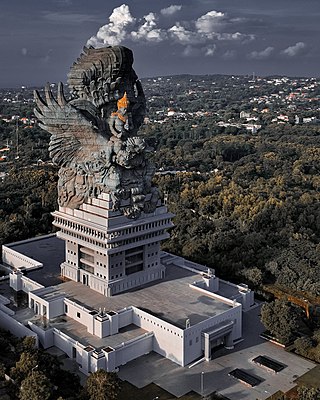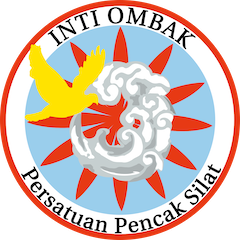
Silat Melayu, also known as Seni Persilatan Melayu or simply Silat, is a combative art of self-defence from the Malay world, that employs langkah ('steps') and jurus ('movements') to ward off or to strike assaults, either with or without weapons. Silat traced its origin to the early days of Malay civilisation, and has since developed into a fine tradition of physical and spiritual training that embodies aspects of traditional Malay attire, performing art and adat. The philosophical foundation of modern Malay Silat is largely based on the Islamic spirituality. Its moves and shapes are rooted from the basis of Silat movements called Bunga Silat, and Silat performances are normally accompanied with Malay drum assembles.

Minangkabau people, also known as Minang, are an Austronesian ethnic group native to the Minangkabau Highlands of West Sumatra, Indonesia. The Minangkabau's West Sumatera homelands was the seat of the Pagaruyung Kingdom, believed by early historians to have been the cradle of the Malay race, and the location of the Padri War.

The karambit or kerambit, kurambik or karambiak is a small curved knife resembling a claw, associated with the Malays in Minangkabau of West Sumatra, Indonesia. The karambit is one of the weapons commonly used in pencak silat and Filipino martial arts.
Datuk is a Malay title commonly used in Brunei, Indonesia, and Malaysia, as well as a traditional title by Minangkabau people in West Sumatra, Indonesia.

The culture of Indonesia has been shaped by the interplay of indigenous customs and diverse foreign influences. With over 1,300 distinct ethnic groups, including significant Austronesian and Melanesian cultures, contributing to its rich traditions, languages, and customs, Indonesia is a melting pot of diversity. Positioned along ancient trade routes between the Far East, South Asia, and the Middle East, the country has absorbed cultural practices influenced by Hinduism, Buddhism, Confucianism, Islam, and Christianity. These influences have created a complex cultural tapestry that often differs from the original indigenous cultures.

Pencak silat is an umbrella term for a class of related Indonesian martial arts. In neighbouring countries, the term usually refers to professional competitive silat. It is a full-body fighting form incorporating strikes, grappling, and throwing, in addition to weaponry. Every part of the body is used and subject to attack. Pencak silat was practiced not only for physical defense but also for psychological ends. There are hundreds of different pencak silat styles and schools which tend to focus either on strikes, joint manipulation, weaponry, or some combination thereof.

Randai is a folk theater tradition of the Minangkabau ethnic group in West Sumatra, Indonesia, which incorporates music, singing, dance, drama and the martial art of silat. Randai is usually performed for traditional ceremonies and festivals, and complex stories may span a number of nights. It is performed as a theatre-in-the-round to achieve an equality and unity between audience members and the performers. Randai performances are a synthesis of alternating martial arts dances, songs, and acted-out scenes. Stories are delivered by both the acting and the singing and are mostly based upon Minangkabau legends and folktales. Randai originated early in the 20th century out of a fusion of local martial arts, story-telling, and other performance traditions. Men originally played both the male and female characters in the story, but since the 1960s, women have also participated.

Silat is the collective term for a class of martial arts from the Nusantara and surrounding geocultural areas of Southeast Asia. It is traditionally practised in Brunei, Indonesia, Malaysia, Singapore, Southern Thailand, Southern Philippines and Southern Vietnam. There are hundreds of different styles (aliran) and schools (perguruan) which tend to focus either on strikes, joint manipulation, weaponry, or some combination thereof.

The Overseas Minangkabau is a demographic group of Minangkabau people of Minangkabau Highlands origin in Central Sumatra, Indonesia who have settled in other parts of the world. Over half of the Minangkabau people can be considered overseas Minangkabaus. They make up the majority of the population of Negeri Sembilan and Pekanbaru. They also form a significant minority in the populations of Jakarta, Bandung, Medan, Batam, Surabaya and Palembang in Indonesia as well as Kuala Lumpur, Malacca, Penang, Singapore and Brunei Darussalam in the rest of the Malay world. Minangkabaus have also emigrated as skilled professionals and merchants to the Netherlands, United States, Saudi Arabia and Australia. The matrilineal culture and economic conditions in West Sumatra have made the Minangkabau people one of the most mobile ethnic group in Maritime Southeast Asia.

Merantau, released in some countries as Merantau Warrior, is a 2009 Indonesian martial arts action film written, directed and edited by Gareth Huw Evans, and starring Iko Uwais. The film marked Uwais' debut as an actor and was the first collaboration between director Evans and star Uwais. It also marks the acting debut of Yayan Ruhian, who, along with Uwais, Evans met while shooting for a documentary in Indonesia. It was this documentary which introduced Evans to the martial art of Pencak Silat.

Listed here are the weapons of pencak silat. The most common are the machete, staff, kris, sickle, spear, and kerambit. Because Southeast Asian society was traditionally based around agriculture, many of these weapons were originally farming tools.

Raden Nganten Nurnaningsih was an Indonesian actress. She has been described as Indonesia's first sex bomb.

Djadoeg Djajakusuma was an Indonesian film director and promoter of traditional art forms. Born to a nobleman and his wife in Temanggung, Central Java, Djajakusuma became interested in the arts at a young age, choosing to pursue a career in theatre. During the Japanese occupation from 1943 to 1945 he was a translator and actor, and in the four-year national revolution which followed he worked for the military's educational division, several news agencies, and in drama.

Tjambuk Api is a 1958 Indonesian martial arts film directed by D. Djajakusuma and produced by Usmar Ismail. Starring Bambang Irawan, Aminah Cendrakasih, Soekarno M. Noer, and Rendra Karno, it tells of a young villager who must challenge a local criminal to be with his love. The film underwent several modifications over a period of more than a year before it could pass the censorship board, but now remains one of Djajakusuma's better known works.

Inti Ombak is a style of pencak silat which blends martial arts descended from the Mataram Kingdom of Central Java with those hailing from the island of Madura. In English it is often abbreviated to IOPS, short for "Inti Ombak Pencak Silat". The Inti Ombak Pencak Silat Union is guided by three caretakers in accordance with the Javanese adage "In the front as a leader, in the middle as a moderator, in the back as an advocate". The current caretakers are Ki Poleng Sudamala of Yogyakarta, Daniel Prasetya of Colorado, and Tjahjadi Tanudjaya of Tengerang. The school's international headquarters are located in Yogyakarta, Indonesia while the US headquarters are in Ault, Colorado.

Indonesian martial arts includes a variety of fighting systems native to or developed in the archipelago of Indonesia, both the age-old traditional arts, and the more recently developed hybrid combatives. In the Indonesian language the term bela-diri is used to mean martial art, and in essence the Indonesian fighting arts are meant as one's defence against perceived threat and assault. Other than physical training, they often include spiritual aspects to cultivate inner strength, inner peace and higher psychological ends.
Huriah Adam was a famous dance artist from West Sumatra.

Minangkabau culture is the culture of the Minangkabau ethnic group in Indonesia, part of the Indonesian culture. This culture is one of the two major cultures in the Indonesian archipelago which is very prominent and influential.

Pencak Silat Harimau also known as Silat Harimau is a Minangkabau style of pencak silat originating from West Sumatra, Indonesia. Silat Harimau has movements that are used to resemble the technique and philosophy of a tiger. Silat harimau has agile techniques and beautiful movements. However, behind these techniques and movements, there are various deadly attacks that are applied to immobilize the enemy very quickly.

















